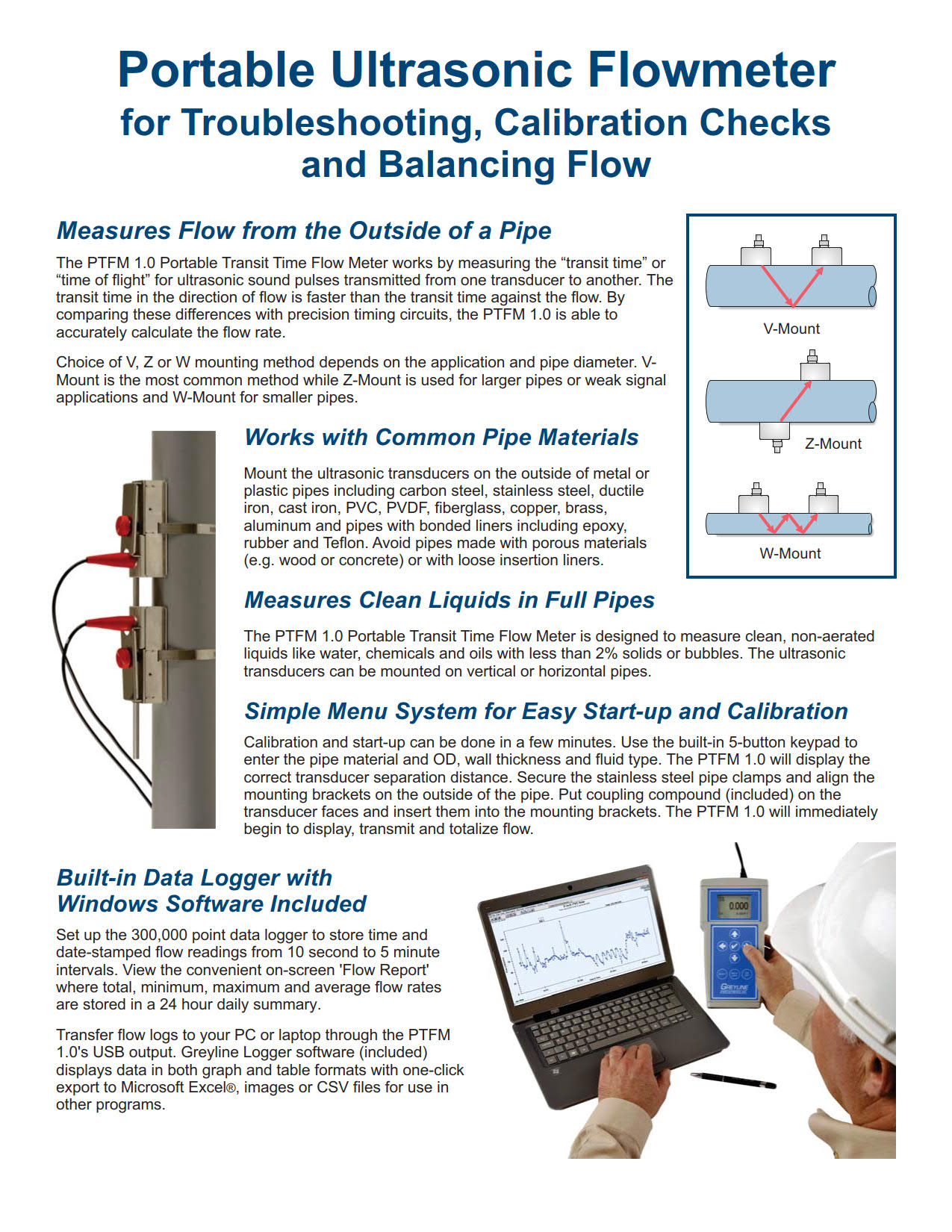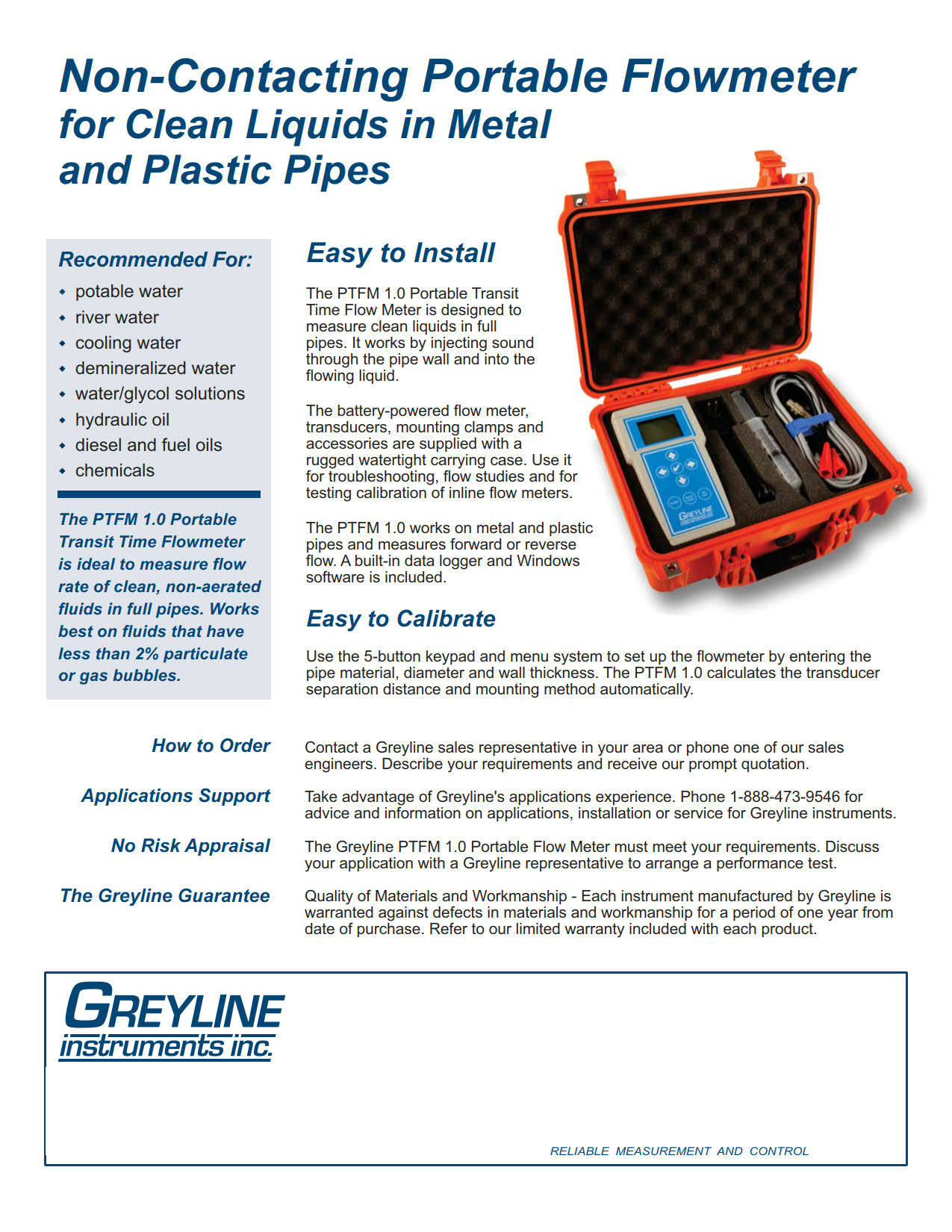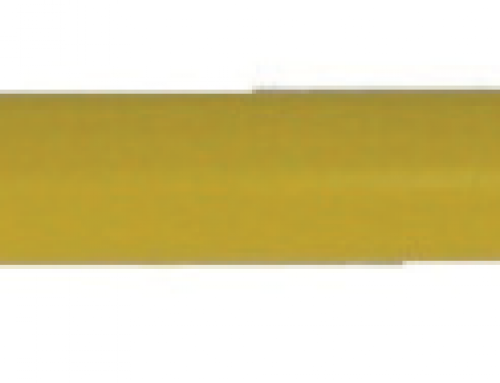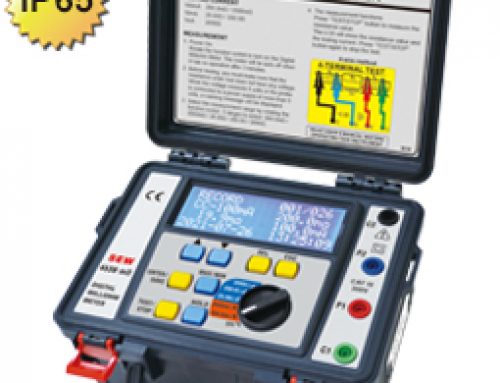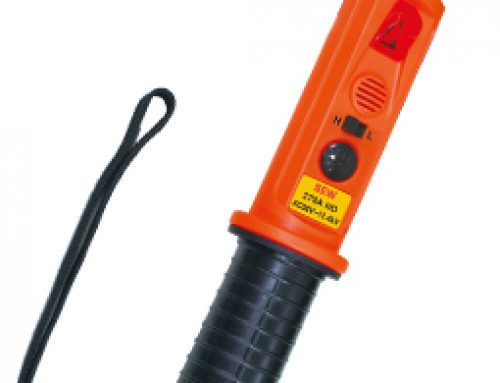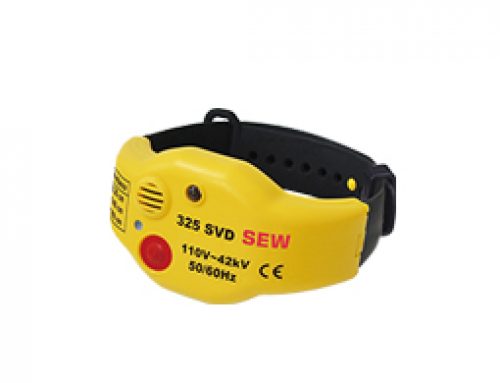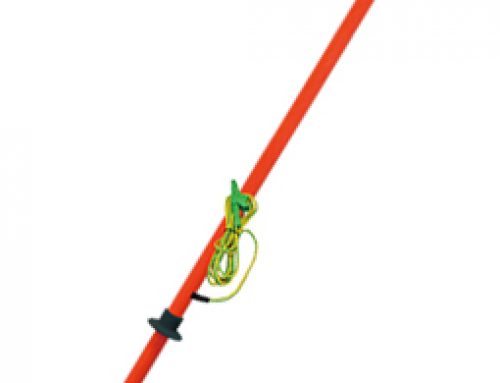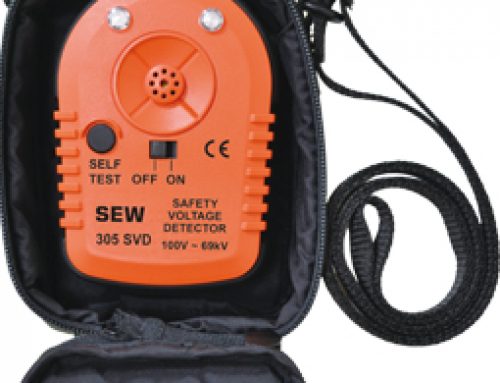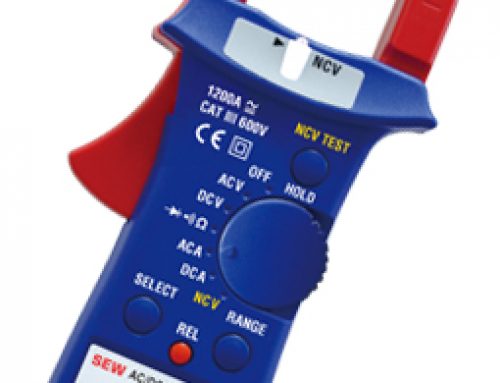PTFM 1.0便携式瞬时流量计
- 非接触式夹紧式超声波换能器适用于金属和塑料管道
- 大型背光流量显示和累加器
- 隔离4-20mA输出
- 内置5键校准器
- 300,000点数据记录器
PTFM 1.0 Portable Transit Time Flow Meter
- Non-Contacting Clamp-on Ultrasonic Transducers Works on Metal and Plastic Pipes
- Large Backlit Flow Rate Display and Totalizer
- Isolated 4-20mA Output
- Built-in 5-Key Calibrator
- 300,000 point data logger
PTFM 1.0便携式流量计
推荐用于水,乙二醇,油和化学品等液体。用于校准,故障排除,流量测量以及作为临时变送器来替换在线流量计。
PTFM 1.0超声波换能器夹在直径为2“至48”(50至1200 mm)的管道外侧。超声波信号通过普通的管道材料工作,包括碳钢,不锈钢,球墨铸铁,铸铁,PVC,PVDF,玻璃纤维,铜,黄铜,铝和带有粘合衬里的管道,包括环氧树脂,橡胶和特氟隆。可以在不关闭流量的情况下安装换能器,并且没有阻塞或压降。它测量并累计正向和反向流动。
PTFM 1.0便携式瞬时流量计通过测量从一个传感器传输到另一个传感器的超声波脉冲的“传输时间”或“飞行时间”来运行。根据安装配置,信号可能会穿过管道一次,两次或四次。为了测量流量,在上游和下游行进的超声信号之间比较传播时间。
用户友好的操作系统
使用屏幕菜单系统可轻松进行校准。只需输入管道直径,壁厚和管道材料即可。PTFM 1.0由内部可充电镍氢电池供电,或者可以使用交流电源适配器连续运行。每个PTFM 1.0都包括一个防水的手提箱,传感器组,电缆和安装夹。
带有Windows软件的内置数据记录器包括?d
设置300,000点数据记录器,以10秒到5分钟的间隔存储时间和日期标记的流量读数。查看方便的屏幕“流量报告”,其中总流量,最小值,最大值和平均流量存储在24小时每日摘要中。
通过PTFM 1.0的USB输出将流量日志传输到PC或笔记本电脑。Greyline Logger软件(随附)以图形和表格格式显示数据,只需单击一次导出到Microsoft Excel ,图像或CSV文件即可在其他程序中使用。
有关您的应用中的具体建议,请联系Greyline Instruments。
PTFM 1.0 Portable Flowmeter
Recommended for fluids like water, glycol, oils and chemicals. Use it for calibrations, troubleshooting, flow surveys and as a temporary transmitter to replace inline flowmeters.
The PTFM 1.0 ultrasonic transducers clamp-on the outside of pipes from 2″ to 48″ (50 to 1200 mm) diameter. The ultrasonic signal works through common pipe materials including carbon steel, stainless steel, ductile iron, cast iron, PVC, PVDF, fiberglass, copper, brass, aluminum and pipes with bonded liners including epoxy, rubber and Teflon. Transducers can be mounted without shutting down flow and there is no obstruction or pressure drop. It measures and totalizes forward and reverse flow.
The PTFM 1.0 Portable Transit Time Flow Meter operates by measuring the “transit time” or “time of flight” for ultrasonic sound pulses transmitted from one transducer to another. Depending on the mounting configuration the signal may cross the pipe once, twice or four times. To measure flow the transit time is compared between ultrasonic signals travelling upstream and downstream.
User-Friendly Operating System
Calibration is easy with the onscreen menu system. Just enter the pipe diameter, wall thickness and pipe material. The PTFM 1.0 is powered by an internal, rechargeable NiMH battery or can be operated continuously with AC power adapter. Each PTFM 1.0 includes a watertight carry case, transducer set, cables and mounting clamps.
Built-in Data Logger with Windows Software Included
Set up the 300,000 point data logger to store time and date-stamped flow readings from 10 second to 5 minute intervals. View the convenient on-screen ‘Flow Report’ where total, minimum, maximum and average flow rates are stored in a 24 hour daily summary.
Transfer flow logs to your PC or laptop through the PTFM 1.0’s USB output. Greyline Logger software (included) displays data in both graph and table formats with one-click export to Microsoft Excel, images or CSV files for use in other programs.
Contact Greyline Instruments for specific recommendations in your application.
便携式超声波流量计技术条件
范围:本规范包括一个便携式超声波传输时间流量计,由Greyline Instruments,Largo,Florida/Long Sault,Ontario制造。该便携式仪器应提供完整管道中流量的非侵入式流量测量、指示、汇总和传输。
一般:
每个便携式运输时间流量计应具有以下设计特点和工程规范:
A.性能规范
超声波流量计的精度应为读数的±1%或0.1 ft/sec(0.03 m/sec),以较大者为准。
重复性和线性度为±0.25%。
应在固体或气泡含量小于2%的完整管道中的清洁液体上操作,流速为±0.07至39 ft/sec(±0.02至12 m/sec)。
操作以下管道材料:碳钢、不锈钢、聚氯乙烯、聚偏氟乙烯、玻璃纤维、镀锌钢、软钢、球墨铸铁、玻璃、铜、黄铜和带有粘合衬的管道,包括水泥、环氧树脂、橡胶和特氟龙。
使用交流电源或内部充电电池进行操作。
B.传感器
流量计应具有双发送/接收夹持式传感器,工作频率为1.28MHz。
传感器应在-40°F至300°F(-40°C至150°C)的温度下连续工作。
标准传感器对应设计为安装在公称直径为2“至48”(50 mm至1200 mm)的管道上。
有12英尺(3.4米)长的同轴电缆,从带有BNC连接器的电子设备到传感器。
应包括制造商推荐的传感器耦合化合物。
应包括不锈钢安装硬件、管夹和铝定位杆。
应包括用于传感器在潮湿或淹没条件下运行的BNC密封套。
C.电子
有一个便携式的ABS电子外壳和一个衬垫,防水的IP67手提箱。总重量应小于15磅(7千克)。
电子设备应设计为在-5°至140°F(-20°至60°C)的温度下连续运行。
有一个内置的5键校准键盘,操作员可通过菜单校准系统的视觉提示选择参数。
不接受需要通过参数代码或外部校准器进行校准的系统。
具有用户可选择的菜单语言,包括英语、法语和西班牙语。
有一个白色的背光矩阵显示器,以用户选择的工程单位显示流量、总流量、校准单位和信号强度。
具有显示屏背光亮度调节功能,降低功耗。
流量比例4-20mA输出,额定最大电阻负载为500欧姆。
内置30万点数据记录器、USB输出和连接电缆。数据记录器应支持时间和日期标记的日志记录,并生成格式化的流报告,包括总计、平均值、最小值、最大值和发生次数。
包括用于数据日志检索、绘图和导出的Windows软件。
具有自动信号强度和信号置信度监测。
有键盘可调的最小流量切断。
应包括带CE/UL认证充电器的外部充电器,100-240VAC 50/60Hz输入。
应包括一个内部镍氢可充电电池,最小容量为18小时连续电池运行。
有一个电池状态指示灯,自动关闭低电池和电池过充电保护。
使用户可选择的“睡眠模式”与数据记录器采样率同步,以降低电池功耗。
D.根据需要插入规范的可选功能:
包括额外的150 g。
制造商推荐的超声波传感器耦合化合物。
包括50英尺(15米)长的传感器电缆延长线,连同连接插头。
E.制造商
仪器应为Greyline Instruments Inc.制造的PTFM 1.0型便携式运输时间流量计,并保证一年内不会出现材料和工艺缺陷。
规格如有更改,恕不另行通知。如果您在申请中需要更多信息或建议,请联系Greyline。我们可以提供报价,并向贵公司所在地区的Greyline销售代表咨询。
PORTABLE ULTRASONIC FLOW METER SPECIFICATIONS
SCOPE: This specification covers a portable, ultrasonic Transit Time flow meter by Greyline Instruments, Largo, Florida / Long Sault, Ontario. This portable instrument shall provide for non-intrusive flow measurement, indication, totalizing and transmitting of the flow rate in a full pipe.
GENERAL:
Each portable Transit Time flow meter shall have the following design features and engineering specifications:
A. PERFORMANCE SPECIFICATIONS
The ultrasonic flow meter shall have an accuracy of ±1% of reading or 0.1 ft/sec (0.03 m/sec), whichever is greater. Have repeatability and linearity of ±0.25%.
Shall operate on clean liquids in full pipes with less than 2% solids or gas bubbles at flow velocities from ±0.07 to 39 ft/sec (±0.02 to 12 m/sec).
Operate on the following pipe materials: carbon steel, stainless steel, PVC, PVDF, fiberglass, galvanized steel, mild steel, ductile iron, glass, copper, brass and pipes with bonded liners including cement, epoxy, rubber and Teflon.
Operate on AC power or from internal, rechargeable batteries.
B. TRANSDUCERS
The flow meter shall have a dual transmitting/receiving, clamp-on transducers operating at 1.28MHz.
The transducers shall operate continuously at temperatures from -40°F to 300°F (-40°C to 150°C).
The standard transducer pair shall be designed to install on pipes with nominal diameter ranging from 2″ to 48″ (50 mm to 1200 mm).
Have 12 ft (3.4 m) length coaxial cables from the electronics with BNC connectors to transducers.
Shall include manufacturer’s recommended transducer coupling compound. Shall include stainless steel mounting hardware, pipe clamps and aluminum alignment bar.
Shall include BNC seal jackets for transducer operation in wet or submerged conditions.
C. ELECTRONICS
Have a portable ABS electronics enclosure with a padded, watertight IP67 carrying case. Total weight shall be less than 15 lbs (7 kg).
Electronics shall be designed for continuous operation at temperatures from -5° to 140°F (-20° to 60°C).
Have a built-in 5-key calibration keypad with operator selection of parameters through visual prompts from a menu calibration system. Systems requiring calibration by Parameter codes or external calibrators shall not be accepted.
Have user-selectable menu languages including English, French and Spanish.
Have a white, backlit matrix display indicating flow in user-selected engineering units, totalized flow, units of calibration, and signal strength.
Have display backlight brightness adjustment for reduced power consumption.
Have flow proportional 4-20mA output rated to maximum resistive load of 500 ohms.
Have a built-in 300,000 point data logger, USB output and connecting cables. Data logger shall support time and date-stamped logging and generate formatted flow reports including total, average, minimum, maximum and times of occurrence.
Include Windows software for data log retrieval, graphing and export.
Have automatic signal strength and signal confidence monitoring.
Have keypad adjustable minimum flow rate cutoff.
Shall include an external with CE/UL approved charger with 100-240VAC 50/60Hz input.
Shall include an internal NiMH rechargeable battery with minimum capacity for 18 hours continuous battery operation.
Have a battery status indicator with automatic low battery shut off and battery overcharge protection.
Have user-selectable “sleep mode” synchronized to data logger sample rate for reduced battery power consumption.
D. OPTIONAL FEATURES FOR INSERTION IN SPECIFICATION AS REQUIRED:
Include additional 150 g. manufacturer’s recommended ultrasonic sensor coupling compound.
Include 50 ft (15 m) length Sensor Cable extension complete with connecting plugs.
E. MANUFACTURER
The instrument shall be a Model PTFM 1.0 Portable Transit Time Flow Meter as manufactured by Greyline Instruments Inc., and warranted against defects in materials and workmanship for one year.
Specifications are subject to change without notice. Please contact Greyline if you need more information or for advice in your application. We can provide quotations and refer you to the Greyline sales representative in your area.
流量计运作原理
仪器电子设备测量从发送声音到回声返回所需的时间。根据空气中的声速,可以高精度计算出液体表面与传感器的准确距离(0.25%范围)。
由于声速受空气温度的影响,灰线超声波液位传感器包括一个内置的温度传感器。水平/距离测量在传感器的整个工作温度范围内自动进行温度补偿。
传感器的位置应使其能清楚地“看到”液体表面,远离梯子、管道或其他障碍物。Greyline建议每10英尺深度距离侧壁1英尺(每3米深度300毫米)。来自搅拌器的假回波(在传感器下扫过)、湍流和波可以被仪器过滤和忽略。
Greyline模型的范围从简单的4-20mA液位指示发送器,到复杂的监控、控制和数据记录模型。返回greyline产品了解级别模型详细信息和规格。有关包括超声波在内的各种液位仪表技术的信息,请参阅废水液位测量技术。
测量管外脏污或充气液体的流量
多普勒效应由奥地利物理学家克里斯蒂安·多普勒于1842年提出。我们每天都能听到多普勒的例子:火车经过时的汽笛声改变音调,或者赛车驶过我们的位置时的排气噪音。
多普勒技术只适用于含有固体或气泡的液体来反射其信号。这些是“困难”的液体,可能会损坏常规流量计:泥浆、污泥、废水、磨料、粘性和腐蚀性化学品。由于传感器安装在管道外部,因此没有压降,也没有流动障碍物。
为了获得很好性能,多普勒传感器应安装在远离湍流产生装置(如弯管和三通)的地方,远离速度增加装置(如控制阀和泵)。典型精度为满刻度的±2%。多普勒仪器包括一个夹式超声波传感器、连接电缆和一个电子外壳,可以安装在附近方便的位置(500英尺/152米范围内)。传感器可以本质安全地额定安装在危险的额定位置。
需要非常精确的定时电路,但当传感器可以安装在流量均匀分布的管段上时,1%的精度非常典型。
由于超声波信号必须穿过管道到达接收传感器,因此流体中不得含有大量气泡或固体(小于2%)。否则高频声音会减弱,太弱,无法穿过管道。应用包括饮用水、冷却水、水/乙二醇溶液、液压油、燃油和化学品。
渡越时间传感器通常工作在1-2兆赫的频率。高频设计通常用于较小的管道,低频设计用于直径达数米的大型管道。
水槽和堰是专门设计的渠道形状,以表征水流。常见的类型有矩形堰、V型槽堰、Parshall水槽和Palmer Bowlus水槽。水槽或堰型的选择取决于应用:流速、渠道形状和水的固体含量。请联系Greyline Instruments以获取有关为您的应用选择合适水槽或堰的建议。
灰线明渠流量计可以通过菜单选择校准到水槽或堰。明渠流量计电子设备使用内部公式计算流量(流量=k h n,其中“k”和“n”为常数,“h”为仪器测量的压头)。通过直接输入“k”和“n”常数,可以对不常见或自定义水槽进行校准。Greyline还提供了一个PC软件程序“find k&n”,用于根据水槽或堰流图开发校准常数。
Greyline明渠流量计包括非接触式超声波传感器、连接电缆和电子外壳,可安装在附近方便的位置(500 ft/152 m内)。传感器可以本质安全地额定安装在危险的额定位置。仪器显示、汇总、传输和控制,有些型号包括数据记录/流量报告系统。
在没有水槽或堰的情况下测量明渠流量。面积速度流量计连续测量水位和流速,以计算明渠或管道中的流量。
超声波传感器安装在管道或通道的底部。为了测量水位,传感器发送超声波脉冲,这些脉冲通过水传播并从液体表面反射出来。仪器精确测量回声返回传感器所需的时间。根据水中声速,测量声级精度为±0.25%。
用连续注入水中的超声多普勒信号测量流速。这种高频声音(640kHz)从悬浮在液体中的颗粒或气泡反射回传感器。如果流体在运动,回声以与流速成比例的变化频率返回。利用该技术,仪器测量流速的精度为±2%。
greyline面积流速流量计工作在部分满管和溢流管、矩形、梯形和蛋形通道中。
可选-单独的液位和速度传感器
一个单独的向下看超声波传感器可用于高充气或湍流应用。它通过将超声波脉冲通过空气传输到液体表面来测量液位,精度为±0.25%。在水位传感器的基础上,采用水下多普勒速度传感器对水位进行测量。
HOW IT WORKS
The instrument electronics measure the time it takes from transmitted sound to return of the echo. With reference to the speed of sound in air, the exact distance of the liquid surface from the sensor can be calculated with high accuracy (±0.25% of maximum range).
Since the speed of sound is affected by air temperature, Greyline ultrasonic level sensors include a built-in temperature sensor. Level/distance measurements are automatically temperature compensated throughout the operating temperature range of the sensor.
The sensor should be positioned so that it has a clear “view” of the liquid surface and away from ladders, pipes or other obstructions. Greyline recommends 1 ft. from the sidewall for every 10 ft. depth (300 mm for every 3 m depth). False echoes from agitators (sweeping under the sensor), turbulence and waves can be filtered and disregarded by the instrument.
Greyline models range from simple 4-20mA level indicating transmitters, to sophisticated monitoring, controlling and data logging models. Return to Greyline Products for Level model details and specifications. For information on a wide range of level instrument technologies including ultrasonics, read Wastewater Level Measurement Techniques.
Doppler flow meters measure flow from outside a pipe with a clamp-on sensor. Greyline Doppler meters continuously transmit high frequency sound (640 kHz) that travels through the pipe wall and into the flowing liquid. Sound is reflected back to the sensor from solids or bubbles in the fluid. If the fluid is in motion, the echoes return at an altered frequency proportionate to flow velocity. Doppler flow meters continuously measure this frequency shift to calculate flow.
Measure Flow of dirty or aerated Liquids from Outside a Pipe
The Doppler effect was first documented in 1842 by Christian Doppler, an Austrian physicist. We hear everyday examples of Doppler: the sound of a train whistle changing pitch as it passes by, or the exhaust noise from a race car as it speeds past our location.
The Doppler technique only works on liquids which contain solids or gas bubbles to reflect its signal. These are “difficult” liquids that may damage regular flow meters: slurries, sludge, wastewater, abrasives, viscous and corrosive chemicals. Because the sensor mounts on the outside of the pipe, there is no pressure drop and no obstruction to flow.
For best performance Doppler sensors should be mounted away from turbulence creating devices like pipe elbows and tees, and away from velocity increasing devices like controlling valves and pumps. Typical accuracy is ±2% of full scale. Doppler instruments include a clamp-on ultrasonic sensor, connecting cable and an electronics enclosure which can be mounted at a convenient location nearby (within 500 ft / 152 m). Sensors can be rated intrinsically safe for mounting in hazardous-rated locations.
Very accurate timing circuits are required but 1% accuracy is quite typical when the transducers can be mounted on a pipe section with evenly distributed flow.
Because the ultrasonic signal must cross the pipe to a receiving transducer, the fluid must not contain a significant concentration of bubbles or solids (less than 2%). Otherwise the high frequency sound will be attenuated and too weak to traverse the pipe. Applications include potable water, cooling water, water/glycol solutions, hydraulic oil, fuel oils and chemicals.
Transit Time transducers typically operate in the 1-2 MHz frequencies. Higher frequency designs are normally used in smaller pipes and lower frequencies for large pipes up to several meters in diameter.
Flumes and weirs are specially designed channel shapes that characterize the flow of water. Common types are Rectangular Weirs, V-Notch Weirs, Parshall flumes and Palmer Bowlus flumes. The choice of flume or weir type depends on the application: flow rate, channel shape and solids content of the water. Contact Greyline Instruments for advice on selection of a suitable flume or weir for your application.
Greyline open channel flow meters can be calibrated to any flume or weir by menu selection. The open channel flow meter electronics use an internal formula to calculate flow rate (Flow = K Hn, where ‘K’ and ‘n’ are constants and ‘H’ is Head as measured by the instrument). Calibration to uncommon or custom flumes can be done by direct entry of ‘K’ and ‘n’ constants. Greyline also offers a PC software program “Find K&n” to develop calibration constants from a flume or weir flow chart.
Greyline open channel flow meters include a non-contacting ultrasonic sensor, connecting cable and an electronics enclosure which can be mounted at a convenient location nearby (within 500 ft / 152 m). Sensors can be rated intrinsically safe for mounting in hazardous-rated locations. The instruments display, totalize, transmit and control, and some models include data logging/flow reporting systems.
Measure open channel flow without a flume or weir An Area-Velocity Flow Meter continuously measures both Level and Velocity to calculate flow volume in an open channel or pipe.
The ultrasonic sensor is installed at the bottom of a pipe or channel. To measure water level the sensor transmits ultrasonic pulses that travel through the water and reflect off the liquid surface. The instrument precisely measures the time it takes for echoes to return to the sensor. Based on the speed of sound in water, the level is measured with accuracy of ±0.25%.
Flow velocity is measured with an ultrasonic Doppler signal continuously injected into the water. This high frequency sound (640 KHz) is reflected back to the sensor from particles or bubbles suspended in the liquid. If the fluid is in motion, the echoes return at an altered frequency proportionate to flow velocity. With this technique the instrument measures flow velocity with accuracy of ±2%.
Greyline Area-Velocity Flow Meters work in partially full and surcharged pipes, rectangular, trapezoid and egg-shaped channels.
Optional – Separate Level and Velocity Sensors
A separate down-looking ultrasonic sensor can be used for highly aerated or turbulent flow applications. It measures level by transmitting ultrasonic pulses through the air to the liquid surface with accuracy of ±0.25%. Along with the level sensor, a submerged Doppler velocity sensor is used to measure the water velocity.








